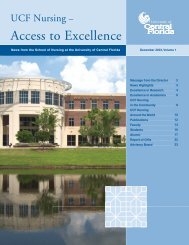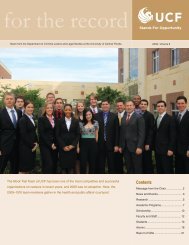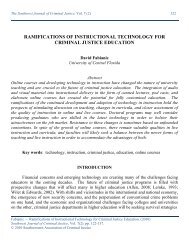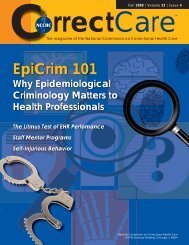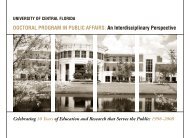UCF Emergency Operations Center Design Jennifer Fleischman ...
UCF Emergency Operations Center Design Jennifer Fleischman ...
UCF Emergency Operations Center Design Jennifer Fleischman ...
You also want an ePaper? Increase the reach of your titles
YUMPU automatically turns print PDFs into web optimized ePapers that Google loves.
<strong>UCF</strong> <strong>Emergency</strong> <strong>Operations</strong> <strong>Center</strong> <strong>Design</strong><br />
<strong>Jennifer</strong> <strong>Fleischman</strong><br />
Graduate Student in the Masters of Public Administration Program<br />
A paper submitted as part of the Service Learning requirements for PAD 6062<br />
Advanced concepts and Application in Public Administration<br />
University of Central Florida<br />
Spring 2011
Abstract<br />
The research contained in the following report surveys institutions of higher<br />
education that subscribed to the DRU Listserv. They were questioned regarding<br />
their <strong>Emergency</strong> <strong>Operations</strong> <strong>Center</strong>s on campus, specifically in the areas of size,<br />
design, <strong>Emergency</strong> Support Functions, and technology. The results of the survey<br />
were used to create recommendations for the University of Central Florida Office of<br />
<strong>Emergency</strong> Management who is currently designing their own fully dedicated<br />
<strong>Emergency</strong> <strong>Operations</strong> <strong>Center</strong> on campus. A literature review on the variables<br />
included within the study are is also included, however, as the topic is still new,<br />
much of the existing research and best practices may not be applicable to<br />
institutions of higher education.
Table of Contents<br />
Abstract ......................................................................................................................................... 2<br />
Table of Contents………………………………………………………………………...3<br />
Introduction ................................................................................................................................. 4<br />
Literature Review ....................................................................................................................... 5<br />
<strong>Emergency</strong> <strong>Operations</strong> <strong>Center</strong>s ............................................................................................................ 6<br />
<strong>Design</strong> - Layout ....................................................................................................................................... 7<br />
<strong>Design</strong> – Personnel ................................................................................................................................. 8<br />
<strong>Emergency</strong> Support Functions ........................................................................................................... 11<br />
Technology ............................................................................................................................................ 12<br />
Survey ......................................................................................................................................... 13<br />
Findings ...................................................................................................................................... 14<br />
Recommendations .................................................................................................................... 18<br />
Conclusion ................................................................................................................................. 21<br />
References .................................................................................................................................. 23<br />
Appendix A – EOC Layouts .................................................................................................. 25<br />
Appendix B - Survey ............................................................................................................... 27<br />
Appendix C – Survey Response Charts .............................................................................. 30
Introduction<br />
<strong>Emergency</strong> Management is an increasingly growing field among institutions of<br />
higher education. What used to be solely police and fire-managed incidents on campuses<br />
are now becoming more commonly coordinated through an Office of <strong>Emergency</strong><br />
Management. However, as <strong>Emergency</strong> Management is still in its infancy, having a<br />
dedication <strong>Emergency</strong> <strong>Operations</strong> <strong>Center</strong> (EOC) on campus, where this coordination<br />
usually takes place, is an extremely uncommon practice in institutions of higher<br />
education. Most universities have only designated a conference room to serve as an EOC<br />
during any large-scale emergency or disaster, ranging from severe weather events such as<br />
hurricanes, to man-made emergencies, such as an active shooter situation. Conference<br />
rooms may assist in providing a working space for the personnel tasked with coordinating<br />
the emergency, yet these rooms are typically too small to accommodate the needed staff<br />
and take a great deal of time to become fully equipped with the needed resources to<br />
manage the emergency.<br />
The University of Central Florida Office of <strong>Emergency</strong> Management is currently<br />
in the process of designing a designated, fully operational <strong>Emergency</strong> <strong>Operations</strong> <strong>Center</strong><br />
for the University to be used during times of disasters and emergencies, as well as<br />
support for special events on campus. The EOC will be built as a renovation project,<br />
utilizing a pre-existing building on the main campus. The focus of this project will be on
the design elements of the EOC, consisting of space requirements, equipment<br />
requirements, and the organization of the <strong>Emergency</strong> Support Functions (ESF) within the<br />
EOC.<br />
In order to draft a design of the EOC, an evaluation of best practices was obtained<br />
from colleges and universities across the United States with EOCs on campus. A survey<br />
was created to measure how these universities are utilizing their EOCs so that<br />
recommendations could be made to <strong>UCF</strong> based on their successes. This research has<br />
identified the following independent and dependent variables, as they relate to the<br />
literature reviewed and the developed survey: the dependent variable in the study is<br />
identified as <strong>Emergency</strong> <strong>Operations</strong> <strong>Center</strong>s, with independent variables consisting of<br />
<strong>Design</strong> of both personnel and layout, <strong>Emergency</strong> Support Functions, and Technology.<br />
The research questions this author is attempting to answer are: what should a campus<br />
EOC look like How should the personnel be positioned within a campus EOC Which<br />
design strategy works best for university campuses What ESF roles should be utilized<br />
within a campus EOC What types of technology should be utilized within an EOC<br />
Literature Review<br />
One of the challenges faced during the course of this research was the lack of preexisting<br />
articles on campus EOCs. The Federal <strong>Emergency</strong> Management Agency<br />
(FEMA), as well as additional subject matter experts in emergency management, has<br />
developed a variety of best practices for EOC design. These recommendations are geared<br />
towards local, state, and federal EOCs, whose needs are likely to deviate from those of a<br />
university EOC. The literature review in this study focuses on these best practices and
attempts to highlight some of the potential challenges facing a university, should they<br />
adopt these recommendations.<br />
FEMA (2003) has highlighted six traditional EOC design features that should be<br />
taken into consideration when building an EOC. Due to financial and other pre-existing<br />
requirements, many of these features have already been established for <strong>UCF</strong>’s EOC.<br />
Therefore, this study focuses solely on the “facility features”, which this author has<br />
identified as design, emergency support functions, and technology.<br />
<strong>Emergency</strong> <strong>Operations</strong> <strong>Center</strong>s<br />
The <strong>Emergency</strong> Management Institute defines an <strong>Emergency</strong> <strong>Operations</strong> <strong>Center</strong><br />
as “the central location from which all off-scene activities are coordinated” (FEMA,<br />
2011). FEMA (2010) highlights a variety of responsibilities designated to the EOC,<br />
including, and not limited to, “establishing policy or resolving conflicting policies,<br />
providing communications/messaging support, providing and prioritizing resources” (p 2-<br />
29).<br />
Romagnoli (2007) outlines two general types of EOCs, full-time, and part-time.<br />
These centers are both used for the same function, yet a full-time EOC is fully stocked<br />
with technology in a dedicated facility. A part-time EOC has a different function on a<br />
daily basis, like a conference room, and becomes an EOC during an emergency situation.<br />
EOCs may also be classified as hot, warm, or cold, depending on their start-up time. A<br />
hot EOC is fully functional and most commonly overlaps with full time EOCs<br />
(Rasmussen, 2009). <strong>UCF</strong>’s EOC is currently a part-time, cold center in a conference<br />
room that serves as an EOC when needed. The disadvantage to a part-time, cold EOC is
that these centers are not typically equipped with the technology required to run an EOC<br />
and therefore take time to become operational. <strong>UCF</strong>’s EOC takes four hours to bring in<br />
the required equipment in order to become fully functional (<strong>UCF</strong>, 2010). When<br />
responding to an incident, time is one of the most important aspects, and part-time EOCs<br />
have the potential to delay important actions and decisions.<br />
<strong>Design</strong> - Layout<br />
The design of an EOC, as it relates to this research, includes the positioning of the<br />
workstations, as well as the grouping of the workers around these stations. The design of<br />
the EOC is critical, as it can have a direct effect on the efficiency and effectiveness of the<br />
work that takes place within the center. The organization of the ESFs designates who<br />
primarily communicates with who and additional interactions among those inside the<br />
EOC.<br />
Five traditional styles of EOC set-up include Boardroom, Mission Control,<br />
Marketplace, Bulls-Eye, and Virtual (Botterell, 2010). Examples of the layouts can be<br />
seen on Appendix A. Bottrell (2010) highlights the pros and cons to each layout option<br />
as follows: Boardroom style allows all members to work at a single table, which allows<br />
better communication flow among personnel. This style may work best when used in<br />
EOCs with a limited amount of personnel. <strong>UCF</strong> currently uses this style in their EOC<br />
due to size constraints on the existing EOC. Mission Control style seats personnel side<br />
by side in rows, all facing the front of the room. One challenge to this set up is that<br />
individuals are limited in who they can work with to those on either side or directly<br />
behind them. Any other interaction would require movement through rows, which can be<br />
distracting and uncomfortable to those working in the center. Marketplace style, one of
the most common EOC set-ups, seats individuals around numerous tables in the center.<br />
This set-up works well when using an Incident Command or Organization by Major<br />
Management Activity style in an EOC, both of which will later be explained in detail. A<br />
Bulls-Eye is similar to a Boardroom set-up, yet contains rings of tables surrounding a<br />
center table. Usually key decision makers are seated in the center of the ring. Finally, a<br />
Virtual EOC allows individuals responding to the EOC the opportunity to respond via<br />
computer connection or video conferencing, rather that physically responding to a central<br />
location. This style is only recommended to support a pre-existing EOC if there are<br />
members who cannot make it to the designated location, not take the place of a psychical<br />
location (Bottrell, 2010).<br />
<strong>Design</strong> – Personnel<br />
The Federal <strong>Emergency</strong> Management Agency (FEMA) has outlined four<br />
organizational structures that serve as best practice recommendations when designing an<br />
EOC. Of these structures, three are applicable to the needs of a university: Incident<br />
Command Structure (ICS), <strong>Emergency</strong> Support Functions (ESF), and Major Management<br />
Activities (FEMA, 2010).<br />
An Incident Command Structure (ICS) utilizes five areas, one Command area and<br />
four functional areas: <strong>Operations</strong>, Planning, Logistics, and Finance/Administration<br />
(FEMA, 2010). These areas are applicable to any incident regardless of its size, by<br />
dividing responsibilities and designating specific roles for all of those involved in<br />
responding to the incident (Anderson, Compton, Mason, 2004). These five areas align<br />
with the positions that responders on the scene of the incident utilize (FEMA, 2010).<br />
Advantages of an ICS structure include clarity of the roles within the EOC, and clear
lines of contact between those on-scene and those within the EOC. However, since the<br />
same titles are used on-scene and in the EOC, there is potential for confusion regarding<br />
command authority (FEMA, 2010). If there are two “Commanders” or two individuals<br />
serving as “<strong>Operations</strong> Section Chief”, personnel may be unsure whose authority to<br />
follow, the individual in the EOC, or the one on the scene of the incident.<br />
An ICS structure may work in a university EOC due to the hierarchical structures<br />
pre-existing in a university setting. Within universities, there is a very rigid chain-ofcommand<br />
that must be followed when decisions are made. For example, at <strong>UCF</strong>,<br />
Coordinators report to Directors, who report to Assistant Vice Presidents, who report to<br />
Associate Vice Presidents, who report to Vice Presidents, etc. An ICS structure utilizes<br />
delegations of authority to make working in a chain-of-command system simpler. This<br />
allows an individual to make decisions on behalf of another in their absence. Delegations<br />
of authority “grant authority to carry out specific functions is issued by chief elected<br />
official, chief executive officer, or agency administrator in writing or verbally; allows the<br />
Incident Commander to assume command; and does not relieve the granting authority of<br />
ultimate responsibility for the incident” (FEMA, 2010). Within <strong>UCF</strong>, a delegation of<br />
authority could be used within the EOC to allow Coordinators to make decisions that<br />
normally a Director would be charged with. Since the ICS structure aligns closely with<br />
the hierarchies in a university, this style may work well within a university setting.<br />
The ESF organization model is similar to an ICS structure, yet personnel within<br />
the EOC are broken into “ESFs” and are organized into pre-determined groups that align<br />
with ICS titles (FEMA, 2010). For example, the <strong>Operations</strong> Section includes Public<br />
Works, Firefighting, Public Health, Urban Search and Rescue, and Public Safety. Each
function is assigned an ESF number with which to identify themselves. The ESF<br />
numbers may differ slightly between jurisdictions, yet they tend to follow a similar<br />
pattern. This set-up works well when using the Marketplace seating arrangement, as the<br />
groups are typically seated around the same workstations (FEMA, 2010). The ICS<br />
structure outlines which agencies should be placed at which table to better coordinate<br />
communication and information sharing. When using the unique ESFs required for<br />
campuses, an ESF structure result in communication confusion across jurisdictions<br />
(FEMA, 2010). For example, <strong>UCF</strong> has identified The Office of Student Disability<br />
Services as ESF 20 for the university. If <strong>UCF</strong>’s ESF 20 were to call Orange County’s<br />
EOC to request additional resources, typically they would work with Orange County’s<br />
ESF 20. Orange County’s EOC does not currently have an ESF 20, which could create<br />
potential communication problems.<br />
Organizing by Major Management Activities may be the most appropriate set-up<br />
for a University. In this model, personnel are broken down into four areas: Policy,<br />
Coordination, <strong>Operations</strong>, and Resources to carry out their assigned tasks (FEMA, 2010).<br />
Within each group, there is additional staff to help support the activities. One challenge<br />
to this is coordinating those on scene with their counterpart within the EOC.<br />
At <strong>UCF</strong>, there are 11 Vice Presidents, each responsible for a different mission of<br />
the University. The Office of <strong>Emergency</strong> Management is located in Facilities and Safety,<br />
which is under the Division of Administration and Finance, as well as the <strong>UCF</strong> Police<br />
Department and Environmental Health and Safety (<strong>UCF</strong>, 2011). These departments and<br />
offices already frequently work together on a daily basis. An Organization by Major<br />
Management Activities Structure may align well with <strong>UCF</strong> requirements where, during
an EOC activation, all personnel who report to the Vice President of the Division of<br />
Administration and Finance would be seated in the same area. This would create better<br />
coordination, as all of the decisions being made in that area already follow the same<br />
chain-of-command.<br />
<strong>Emergency</strong> Support Functions<br />
<strong>UCF</strong> currently utilizes the ESF model within their EOC; therefore an examination<br />
of who fills these seats is necessary. The Florida Division of <strong>Emergency</strong> Management<br />
(FDEM) defines ESFs as “a mechanism that consolidates multiple agencies that perform<br />
similar or like functions into a single, cohesive unit to allow for the better management of<br />
emergency response functions” (FDEM, 2010). For example, ESF 1 is Transportation,<br />
meaning that this ESF would coordinate all transportation requirements during the<br />
incident. At <strong>UCF</strong>, the <strong>UCF</strong> Parking and Transportation Services man ESF 1 during an<br />
EOC activation (<strong>UCF</strong> Office of <strong>Emergency</strong> Management, 2010). In the State system,<br />
ESF 1- Transportation is manned by the Florida Department of Transportation.<br />
The individuals filling the positions of the ESFs hold a great responsibility. They<br />
must be subject matter experts in their field and additionally hold a position where they<br />
have been delegated the authority to make decisions on behalf of their agency or<br />
department. It is imperative that these individuals have access to the resources needed<br />
during a disaster. During non-emergency times, these individuals fulfill their normal<br />
responsibilities within the university.<br />
The <strong>UCF</strong> <strong>Emergency</strong> <strong>Operations</strong> <strong>Center</strong> Plan (2010) outlines operations of the<br />
EOC, the set-up of the EOC, and the requirements and responsibilities of the ESFs during<br />
activation. Chapter 5 of the plan deals directly with the ESFs, and describes in-depth the
ESFs utilized and their position specific responsibilities during a disaster occurring at the<br />
university. Though these had been pre-determined prior to the study, <strong>UCF</strong> is open to<br />
changing their set-up if recommendations show that it would improve their disaster and<br />
event response.<br />
Technology<br />
One of the most valuable resources within the EOC is its communication devices<br />
and technology, as the ability to communicate from the EOC to those with the required<br />
resources on the outside and with incident command is one of the main purposes for an<br />
EOC’s existence. It is therefore recommended that redundant systems of communication<br />
be in place within an EOC, meaning that there are a variety of communication methods<br />
within the center (FEMA, 2010, Harowitz, 2005). These could consist of telephones,<br />
radios, an instant messaging program, etc.<br />
It is also important to ensure that communication systems are interoperable,<br />
meaning that they have the ability to “communicate with staff from other responding<br />
agencies and to exchange voice and/or data communications on demand and in real time”<br />
(FEMA, 2010, p 4-6). Interoperability is especially important for universities due to their<br />
relationship with their County and State <strong>Emergency</strong> Management. If there were needs<br />
that could not be met on campus, the University would look to their surrounding agencies<br />
for assistance. It is imperative that these agencies be able to communicate with one<br />
another to ensure safety of all responders. For example, the <strong>UCF</strong> Police Department may<br />
be responding to an incident that requires the response of a fire department. If Orange<br />
County Fire/Rescue were to respond to the scene, the <strong>UCF</strong> Police Department should be<br />
able to speak with them on the same radio frequency to share information.
FEMA (2010) recommends that all key personnel within the EOC have<br />
access to e-mail, phone, radio, and any data necessary to fulfill their function within the<br />
EOC. Traditionally, EOCs are pre-stocked with these types of equipment. As previously<br />
stated, the <strong>UCF</strong> Office of <strong>Emergency</strong> Management’s EOC currently requires technology<br />
to be brought in before the EOC is operational. Even then, the EOC may be lacking<br />
enough telephones and computers to accommodate for each individual that arrives. This<br />
can potentially be an issue for EOC responders and may require them to supply their own<br />
resources.<br />
EOC Management software is utilized to provide the EOC with information on<br />
weather, support coordination with outside agencies, and track resources. DHS (2010)<br />
outlines a variety of software available for EOCs including WebEOC, “a crisis<br />
information management software that delivers real-time data to emergency managers<br />
and responders” (p 84). WebEOC is one of the most common communication tools used<br />
in EOCs and allows cross communication within the EOC and with external<br />
organizations. Additional popular systems also include Area Locations of Hazardous<br />
Atmospheres (ALOHA) and HURREVAC, both weather-tracking systems, and<br />
Computer-Aided Management of <strong>Emergency</strong> <strong>Operations</strong> (CAMEO), an EOC<br />
management system (Commander Navy Instillations Command, 2005). Although much<br />
of this technology is useful, financial issues tend arise when trying to obtain it. However,<br />
the importance of the technology, access to it, and information gained from it may make<br />
it a larger priority (FEMA, 2010).<br />
Survey
The survey was developed to analyze how other universities across the United<br />
States are using EOCs on their campuses in order to make recommendations for <strong>UCF</strong>.<br />
The survey was developed as a “Google Document” and was then e-mailed to institutions<br />
of higher education that have subscribed as members to the Disaster Resilient University<br />
Listserve, a communication resource created by The University of Oregon which allows<br />
emergency management professionals from institutions of higher education to network<br />
with one-another (University of Oregon, 2011).<br />
The questions contained in the survey were designed to evaluate the variables<br />
outlined in the study. Additional questions were asked pertaining to student enrollment<br />
size and geographic location of the campuses to greater increase the validity of the<br />
recommendations drafted for <strong>UCF</strong>. The survey included both multiple choice questions<br />
and short answer questions with the opportunity for respondents to explain their answers<br />
in greater detail. A copy of the survey can be found on Appendix B.<br />
32 responses were collected. At the request of the survey respondents, the<br />
identity of the Universities who participated in the survey will remain anonymous.<br />
Instead of University names, they will be identified by the size of the student population<br />
within the university. “Small” will include 1- 20,000 students, “medium” will include<br />
20,001-40,000 students, and “large” will include 40,001 or more students.<br />
Findings<br />
The findings from the survey outline the importance of the research, as many of<br />
the EOC designs from the schools surveyed do not match the best practices shown in the<br />
literature review. Further analysis of the survey responses is as follows:
<strong>UCF</strong>’s student population for the 2010-2011 academic year was over 56,000,<br />
making it the second largest university in the United States (Lewis, 2010). Therefore, it<br />
was important to determine the size of the responding schools to establish whether their<br />
EOC sizes and design were comparable to <strong>UCF</strong>’s. Responders to the survey represented<br />
universities from a variety of geographic locations and sizes. The majority held student<br />
populations between 20,001-30,000, and only two were within the population size of<br />
<strong>UCF</strong> (see Appendix C-1).<br />
Having a dedicated EOC on campus can minimize the time delay associated with<br />
bringing in the necessary equipment to make the EOC functional. It is surprisingly then<br />
that only nine respondents indicated that they have a full-time dedicated EOC. This may<br />
be due to space or funding requirements needed establish a dedicated EOC. 22<br />
respondents indicated that although they do not have a dedicated EOC, their campus does<br />
have a space designated as an EOC if needed during an emergency. One large school<br />
indicated that they have three EOCs they can utilize if necessary (see Appendix C-2 and<br />
Appendix C-3).<br />
Sizing of the EOC may vary depending on the population of the jurisdiction and<br />
the personnel staffing the EOC. Unfortunately, the sizes of the respondent’s EOCs do not<br />
coincide with the size of the student populations of the universities. <strong>UCF</strong>’s EOC is<br />
currently 1,600, to accommodate 40 people. Their current conference room cannot<br />
comfortably seat the required personnel, nor does it provide adequate space for their<br />
equipment. Surprisingly, their EOC is one of the larger EOCs compared to others in the<br />
study. The sizes of the actual operations room of the respondent’s EOCs, not including<br />
adjacent facilities, range from between 200 square feet to 3,000 square feet with the
average size around 1,400 square feet. These spaces range from classrooms, to<br />
conference rooms, to fully functional <strong>Emergency</strong> <strong>Operations</strong> <strong>Center</strong>s within a building<br />
entirely dedicated to being an EOC.<br />
From the literature reviewed, it appeared that the Marketplace style may fit a<br />
university EOC’s needs most accurately due to the chain-of command structure that<br />
exists within a university system. However, none of the survey respondents currently use<br />
this form of seating arrangement for their EOCs. This may be due to the size constraints<br />
of the EOCs, as the Marketplace style would require a room that can accommodate<br />
multiple tables and area for movement. Sixteen of the respondents indicated the use of a<br />
Boardroom seating style, while six use Mission Control, and one use Bulls-Eye. None of<br />
the responders utilize the Virtual EOC style (see Appendix C-4).<br />
The literature review revealed that the Incident Command Structure would work<br />
well within a university and the survey results coincide with these findings, and many<br />
have created a combination model. 14 schools indicated the use of an ICS structure, four<br />
use an ESF structure, and nine use a combination of both ICS and ESF structures. Six<br />
responders indicated that they do not use either model (See Appendix C-5). Most of<br />
these have indicated that they have designed an “Annex structure” rather than operating<br />
under ESFs. One large school defines this breakdown as a method using an Alphabet<br />
rather than numbers, where they identify these seat requirements with their own key<br />
players, rather than the traditional ESF breakdown. These responders indicated that they<br />
feel this breakdown is better aligned with university requirements.<br />
For those that utilize the ESF structure, the most frequent ESFs used by the<br />
schools are 1-Transportation, 14-Public Information, and 16-Law Enforcement (See
Appendix C-4). <strong>UCF</strong> currently has seats established for these positions. The respondents<br />
indicated that the individuals who fill the seats of the ESFs are made up of police, fire,<br />
and other first responding agencies, directors of their departments, deans of departments,<br />
and additional outside agencies should they be needed. One unique aspect of the survey<br />
respondents was the amount of deans and vice presidents that are fill ESFs in the EOCs.<br />
<strong>UCF</strong> has identified individuals with decision-making power to fills those roles, but does<br />
not currently have they higher tiered personnel in the center.<br />
A number of schools identified unique ESFs that they have created to fit within<br />
their EOC. <strong>UCF</strong> has currently expanded their ESFs to include Special Needs, Counseling<br />
Services, and Human Resources. One large school within the study has extended their<br />
ESFs to include a research facility and Office of Internal Affairs. Additional ESF seats<br />
include Student Affairs, Risk Services, Continuity and Recovery, Registrar’s Office,<br />
Athletics, and Business.<br />
As the literature review showed, redundant forms of technology and<br />
communication methods should be utilized in an EOC. All of the responders indicated<br />
that they have multiple methods of communication and various types of technology<br />
within their EOCs. The most common types of technology used are televisions, laptops,<br />
and “other” (see Appendix C-7). Respondents indicated that “other” encompassed<br />
projectors, copy-machines, large screen monitors, laminated wallboards, grease-boards,<br />
and cameras. Communication technology consists mostly of Internet and radio; however,<br />
additional unique technology includes UHF radios, video conferencing, HAM radios, and<br />
video conferencing (see Appendix C-8).
WedEOC was the most commonly used EOC management software, followed by<br />
“other” consisting of MS Communicator, Blackboard, and a few respondents indicated<br />
that they are tied into their county’s system (see Appendix C-9). Support EOC software<br />
was most commonly HURREVAC and “other” consisting mostly of online mapping such<br />
as Google or Bing, Weathertap, and National Weather Service chat features (see<br />
Appendix C-10).<br />
Additional questions were posed to respondents as an opportunity for <strong>UCF</strong> to<br />
evaluate training requirements and EOC activations so as to better improve their EOC<br />
functions. The results indicated that ESF training is done through training on the<br />
National Incident Management System (NIMS) courses, which are offered online or inclass<br />
through FEMA. Position specific training for ESF personnel also takes place on<br />
campuses annually. Most schools indicated that they are still in the process of<br />
developing a training plan for their personnel. University EOCs are also used for<br />
command post for football games, a back-up facility for city/county police and fire<br />
departments, community events, graduation commencements, move-in days, dignitary<br />
visits, and additional special events.<br />
Recommendations<br />
Research should be done on EOC design, specific to institutions of higher education.<br />
One of the most significant recommendations obtained from this research is a<br />
requirement for further research to be conducted on institutions of higher education<br />
EOCs. <strong>Emergency</strong> Management within colleges and universities is still in its infancy.
As the field continues to grow, best practice recommendations will need to be<br />
established, specific to this field.<br />
<strong>UCF</strong> Office of <strong>Emergency</strong> Management should include Academics and Research in their<br />
EOC to create easier communication flow<br />
The University of Central Florida should look into the inclusion of academics in<br />
their EOC. Although communication with the Deans may be available during a disaster,<br />
it might be easier to communicate needs and outcomes to them and make<br />
recommendations for actions if they were represented within the EOC. The deans may<br />
not have the same technology available to them outside the EOC, and should<br />
communications fail, they could still articulate their recommendations. This would also<br />
allow them to form decisions needing their approval based on the actions being taken by<br />
the other personnel within the EOC. Inclusion of a representative from research should<br />
be looked at as well. Research is one of the most important missions of a university. An<br />
enormous amount of funding is dedicated to research, yet it also brings in money to the<br />
university. Having a representative of the researchers in the EOC may help to resolve<br />
issues of analyzing the hazards faced if specific research is threatened during a disaster or<br />
emergency.<br />
<strong>UCF</strong> Office of <strong>Emergency</strong> Management should activate their EOC for special events to<br />
increase exercise opportunities.<br />
Activating the EOC to assist with coordination of special events should be<br />
considered an option to adopt. Pre-staging of potentially required personnel that may be
needed if an event were to occur can only help should a situation happen. This will also<br />
provide practice for what these ESFs will need to do during a disaster, since <strong>UCF</strong> only<br />
exercises their EOC annually.<br />
<strong>UCF</strong> Office of <strong>Emergency</strong> Management should adopt an Organization by Major<br />
Management Activity Structure in their EOC.<br />
Utilizing an Organization by Major Management Activity structure may benefit<br />
the <strong>UCF</strong> EOC as well. As shown in the literature review, adoption of this style would<br />
allow better coordination of information to the higher personnel. This style may also<br />
work well with adoption of Annexes in order to institute the additional personnel within<br />
the EOC.<br />
<strong>UCF</strong> should obtain an EOC Software program<br />
In terms of technology, increasing the amount of technology within the EOC will<br />
provide <strong>UCF</strong> with redundant forms of communication should anything arise causing gaps<br />
in communication. Looking into the adoption of an EOC Software management system<br />
will allow easier coordination with county partners. Research into what types of systems<br />
these counties utilize should be done before adopting one of these systems. Additional<br />
support software should be looked into as well to increase intelligence availability within<br />
the EOC. All of these require funding that <strong>UCF</strong> may not have access to at the moment,<br />
therefore, it is recommended that research be done into partnering with the County, or<br />
dedicating time to researching grant opportunities to support the purchase of these<br />
important resources.
Conclusion<br />
In summation, the University of Central Florida’s <strong>Emergency</strong> <strong>Operations</strong> <strong>Center</strong><br />
will certainly be an important improvement to their current EOC. Considerations should<br />
be taken into including both researchers and deans within the EOC, re-evaluating the setup<br />
of the EOC, and utilizing annexes to increase their personnel. <strong>Emergency</strong><br />
management in institutions of higher education will continue to be a growing field. As<br />
the field matures, additional research will most likely be conducted on <strong>Emergency</strong><br />
<strong>Operations</strong> <strong>Center</strong>s and how these requirements differ from local, state, and federal<br />
requirements due to the uniqueness of college campuses.
References<br />
Anderson, A. I., Compton, D., and Mason, T. (2004). Managing in a dangerous world-<br />
The national incident management system. Engineering Management Journal.<br />
16(4)3-9.<br />
Botterell, A. (2010). A design language for EOC facilities (PDF Format). Retrieved on<br />
April 12, 2011from http://www.flghc.org/ppt/09-10/TS%20EM7.pdf.<br />
Commander Navy Instillations Command. (2005). Navy instillations emergency<br />
management program. Volume 2: Appendices.<br />
Department of Homeland Security. (2010). Considerations for fusion center and<br />
emergency operations center coordination: comprehensive preparedness guide<br />
(CPG) 502. Retrieved on April 13, 2011 from<br />
www.fema.gov/pdf/about/divisions/npd/cpg_502_eocfusion_final_7_20_2010.pdf.<br />
Federal <strong>Emergency</strong> Management Agency. (2003). Hardened First Responder Facility:<br />
911 Communication and <strong>Emergency</strong> <strong>Operations</strong> <strong>Center</strong>, Smith County Texas.<br />
Retrieved on April 12, 2011 from<br />
http://www.fema.gov/library/viewRecord.doid=1782.<br />
Federal <strong>Emergency</strong> Management Agency. (2010). IS-200: Incident Command System<br />
for Single Resources and Initial Access Incidents. Retrieved on April 14, 2011<br />
from http://training.fema.gov/emiweb/is/is200b.asp.<br />
Federal <strong>Emergency</strong> Management Agency. (2010). IS-775: EOC Management and<br />
<strong>Operations</strong>. Retrieved on April 13, 2011 from emilms.fema.gov/IS775<br />
Florida Division of <strong>Emergency</strong> Management. (2010). <strong>Emergency</strong> Support Functions.<br />
Retrieved on March 31, 2010 from www.floridadisaster.org/emtools/esf.html<br />
Harowitz, S. L. (2005). <strong>Emergency</strong> operations centers. Security Management.<br />
49(11)62.<br />
Lewis, K.J. (Nov. 3, 2010). Quality Growth: <strong>UCF</strong> is Nation’s Second Largest. <strong>UCF</strong><br />
Today. Retrieved on April 12, 2011 from http://today.ucf.edu/quality-growth-ucfis-nations-second-largest/#more-17537<br />
Rasmussen, C. (2009). <strong>Emergency</strong> operations center operations and management (PDF<br />
format). Retrieved on April 12, 2011 from<br />
http://www.slideshare.net/curtrasmussen/eoc-operations-and-managementtraining-mod-1.<br />
Romagnoli, J., A. (2007, October). Ready for Anything. Security Technology Executive.
17(10)26-28.<br />
University of Central Florida. (2010). <strong>Emergency</strong> <strong>Operations</strong> <strong>Center</strong> Plan.<br />
University of Central Florida. (2011). <strong>UCF</strong> Finance and Accounting. Retrieved on<br />
April 12, 2011 from http://www.fa.ucf.edu/<br />
University of Oregon. (2011). DRU Listserv Policies. Retrieved on March 31, 2010<br />
from http://em.uoregon.edu/info/prepare10/
Appendix A – EOC Layouts<br />
Boardroom<br />
Mission Control<br />
Marketplace
Bulls-Eye<br />
Virtual<br />
All images in Appendix A are from Botterell (2010).
Appendix B - Survey<br />
<strong>UCF</strong> <strong>Emergency</strong> Management - EOC Survey<br />
What College or University are you representing with your responses *<br />
Please explain.<br />
How many students attend your College or University *<br />
Please choose one.<br />
1-10,000<br />
10,001-20,000<br />
20,001-30,000<br />
30,001-40,000<br />
40,001-50,000<br />
50,001-60,000<br />
60,000 or more<br />
Do you have a full time dedicated EOC on campus *<br />
Please choose one, or explain.<br />
Yes<br />
No<br />
Other:<br />
If not, do you have a space designated as an EOC for use during an emergency<br />
Please choose one, or explain.<br />
Yes<br />
No<br />
Not Applicable<br />
Other:<br />
How many square feet is your EOC space<br />
Please explain.<br />
What ESFs fill your seats during a time of disaster<br />
Please choose all that apply.<br />
ESF 1 - Transportation<br />
ESF 2 - Communications/IT<br />
ESF 3 - Public Works<br />
ESF 4 - Fire<br />
ESF 5 - Information and Planning<br />
ESF 6 - Mass Care<br />
ESF 7 - Resource Support
ESF 8 - Health & Medical<br />
ESF 9 - Search & Rescue<br />
ESF 10 - Hazardous Materials<br />
ESF 11 - Food & Water<br />
ESF 12 - Utilities/Energy<br />
ESF 13 - Military Support<br />
ESF 14 - Public Information<br />
ESF 15 - Volunteers<br />
ESF 16 - Law Enforcement<br />
ESF 17 - Animal Services<br />
ESF 18 - Business & Industry<br />
What campus departments or outside agencies fill these seats when activated<br />
Please identify the ESF number and the department that fills that role.<br />
Did you create other ESFs to fill unique roles for your institution If so, what are<br />
they<br />
Please explain.<br />
What style do you utilize to seat your ESFs<br />
Please choose one, or explain.<br />
Incident Command Structure<br />
ESF Structure<br />
Combination<br />
Other:<br />
What style of EOC do you use<br />
Please choose one, or explain.<br />
Marketplace<br />
Board Room<br />
Mission Control<br />
Virtual<br />
Bulls Eye<br />
Other:<br />
What types of technology are used within the EOC<br />
Please choose all that apply.<br />
Smart Boards<br />
Televsions<br />
Desk-Top Computers<br />
Lap-Top Computers<br />
Other:
What types of communication technology do you use in your EOC<br />
Please choose all that apply.<br />
Satellite<br />
Internet<br />
Radios<br />
Voice-Over IP<br />
Other:<br />
What types of EOC management software do you use in your EOC<br />
Please choose all that apply.<br />
WebEOC<br />
E-Team<br />
SharePoint<br />
Other:<br />
What types of support EOC software do you use in your EOC<br />
Please choose all that apply.<br />
HURREVAC<br />
Aloha<br />
Cameo<br />
Weathertap<br />
Other:<br />
How do you train your ESF members and how often<br />
Please explain.<br />
How often do you exercise your EOC team<br />
Please explain.<br />
What other events does your EOC support<br />
Please explain.
Appendix C – Survey Response Charts<br />
1. Student Populations<br />
2. Full-Time EOC<br />
3. Part-Time EOC
4. EOC Style<br />
5. Seating Style<br />
6. ESFs
7. Technology
8. Communication Technology<br />
9. EOC Management Software<br />
10. Support Software



